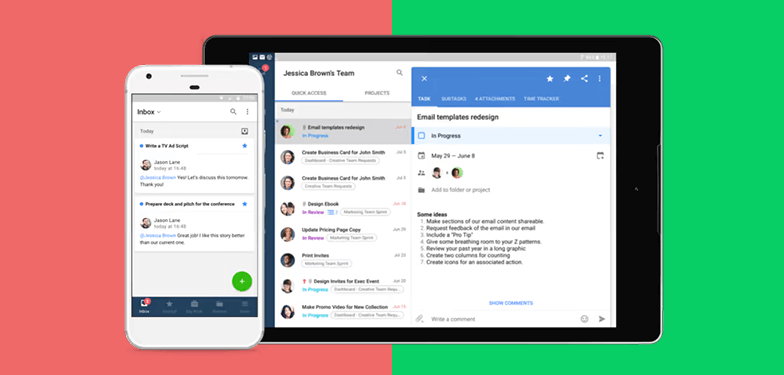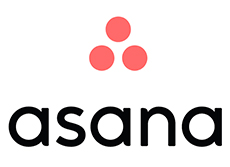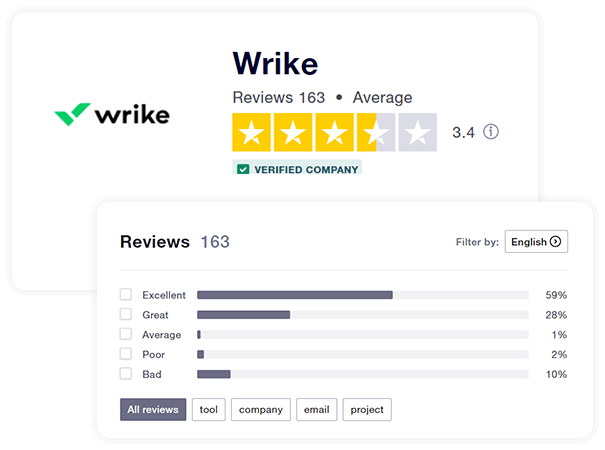1. Ease-of-Use
Both Asana and Wrike are simple to set up. Additionally, each of the PM tools has a dashboard that’s relatively easy to navigate and most of the major functionality you’ll need to access is simple to find. However, these tools offer so many features that neither is particularly beginner-friendly, especially if you’re new to the world of PM software.
Still, between Wrike and Asana, Asana is the easier of the two tools to use. Not only is it somewhat simpler to navigate, but Asana also has a colorful interface that’s very visually appealing.
By contrast, Wrike’s interface looks drab in comparison, and many users think it’s downright ugly. While we feel that’s a bit strong, Wrike’s interface could definitely stand some improvement.
Because Asana offers the better user experience, we’re Team Asana on this one.
2. Pricing
Both Asana and Wrike offer multiple membership tiers, and each tool has a free plan. As of this writing, membership pricing is as follows:

-
BASIC - no cost for teams with up to 15 members
-
PREMIUM - $10.99/month per user, billed annually
-
BUSINESS - $24.99/month per user, billed annually
-
ENTERPRISE - Contact sales

-
FREE - no cost for your entire team
-
PROFESSIONAL - $9.80/month per user, billed monthly
-
PREMIUM - $24.80/month per user, billed monthly
-
ENTERPRISE - Contact sales
-
PINNACLE - Contact sales
Wrike also offers two additional plans--one specifically for marketing teams and another for professional services teams. These plans have custom features geared toward those groups.
While cost shouldn’t be the only factor you consider when purchasing PM software, Asana does cost slightly more than Wrike. And if you opt to pay monthly, Asana’s pricing is considerably more ($13.49/month per user for Premium and $30.49/month per user for Business).
Although that gives Wrike a slight edge in this category, Wrike’s membership plans are confusing and the company’s pricing lacks transparency. For example, the only way to find out how much Wrike’s specialized plans for marketing and professional services teams cost is to contact sales.
Wrike also offers four premium paid add-ons that give users additional functionality:
- Wrike Integrate - to connect Wrike to thousands of apps and create custom automations
- Wrike Two-Way Sync - for tech teams to sync data between Jira and Github
- Wrike Lock - to own and manage the keys to your encrypted data
- Wrike Marketing Insights - for cross-channel digital campaign performance analysis
These add-ons are only available for Business memberships and above, except for Wrike Lock which is accessible exclusively to those on the Enterprise and Pinnacle memberships.
Again, Wrike doesn’t list pricing here, forcing users to contact sales to learn how much these premium add-ons cost. When you couple this nuisance with Wrike’s overly confusing membership options, it’s clear that Wrike could stand to improve on the pricing front … which is why we chose Asana for the win.
3. Free Plan Limits & Restrictions
Although there are a number of things you can do with both Asana and Wrike’s free plans, they do come with various restrictions.
For instance, Asana lets free users create unlimited projects and tasks, while providing them access to three views: list, board, and calendar.
By contrast, Wrike allows its free users to create unlimited projects but they’re limited to just 200 tasks at a time. Once that number of tasks has been reached, users must delete tasks before they can add more. Additionally, Wrike’s free users can access custom work views (e.g., table, Kanban), but they’re restricted from Calendar and Gantt views.
Asana offers its free users unlimited file storage, whereas Wrike limits free users to 2GB of storage space per account. Lastly, Asana’s free plan limits businesses to 15 team members, whereas Wrike’s permits unlimited team members.
Although Asana’s free plan limits teams to just 15 users, it’s still the better deal. Not only do users get unlimited file storage, but they can also create unlimited projects and tasks. With access to so much functionality, small teams may never need to upgrade.
While Wrike does allow teams of any size to use its free plan, since they’re only permitted 200 tasks at a time, it’s really easy to quickly outgrow Wrike freemium. That’s why we chose Asana for the win here.
4. Reporting

Both Asana and Wrike offer reporting features for their higher-tiered memberships (i.e., Asana Premium and Wrike Business). These features allow users to create dashboards and charts displaying project progress, tasks, and board data. Additionally, both PM tools offer Gantt charts and workload planning.
That said, although Asana’s reporting is good, Wrike’s is even better. Wrike users can create in-depth reports following an easy, step-by-step process that actually makes building reports simple, rather than tedious.
Both tools also allow users to export data. For instance, Asana allows users to export data in CSV or PDF format, for use with Microsoft Excel, Google Sheets, and other applications. Wrike users are limited to exporting in XLS (Excel) format.
Although Asana has good reporting features, Wrike’s are slightly better because they’re more powerful and advanced … which is why we chose Wrike for the win here.
5. Mobile App

Both Asana and Wrike offer mobile apps for iOS and Android users.
Users of Asana’s app appreciate the way it’s organized and the vast number of features the app contains. Many also report that Asana’s app really improves collaboration.
Still, some users dislike the Asana app’s lack of templates and push notifications. Additionally, many have noted that the Asana iOS app has better features and is easier to use than Asana’s Android app.
While Wrike app users praise its interface, real-time collaboration capabilities, and the ease with which users can track team members’ progress, some reviewers note that the app has limited capabilities and that navigation isn’t intuitive.
Bottom line? We couldn’t choose a winner for this category. Although the Asana and Wrike apps have the same rating on the Google Play store (4.3), Asana is rated slightly higher on the Apple App Store--4.7, compared to Wrike’s rating of 4.6. Even so, that difference is relatively insignificant, which is why this category is a draw.
6. Customer Service
Both Asana and Wrike offer multiple ways for users to get assistance. For instance, Asana allows all users to contact customer support via form or email, and the company offers live chat--however, chat’s only available for sales or billing-related questions, not tech support. Asana also doesn’t offer tech support via phone.
Still, Asana does have an active user forum and Asana Academy, which contains videos, demos, guides, live training, and online courses for users. Enterprise organizations may also have access to additional support options.
By contrast, Wrike freemium users can contact customer support via web form, whereas those on Wrike’s Standard plan can get support via web form, chat, or phone. Wrike users also have access to Wrike Discover, an e-learning platform containing interactive classes.
We deem Wrike the winner of this category because Wrike offers its users tech support via chat and phone.
7. Integrations

Both Asana and Wrike integrate with a number of other business apps; Asana integrates with 100+ apps, whereas Wrike integrates with more than 200 apps.
While these integrations are available to freemium users, there are some restrictions. Asana, for example, doesn’t integrate with Tableau (a reporting app) or Power BI (a data visualization app) unless you have a Business or Enterprise account.
Wrike freemium users can only integrate with cloud storage platforms, whereas Professional users can also integrate Wrike with productivity apps.
To integrate with Salesforce, QuickBook, or NetSuite, Wrike users need a Business plan. Users on the Business plan or higher can also purchase Wrike’s paid premium add-on, Wrike Integrate, which gives users access to 400+ custom integrations.
This category is a draw. Although Wrike integrates with more apps, Asana’s freemium plan lets users integrate with a much wider variety of apps.
8. Time Tracking
Time tracking is a valuable PM software feature because it allows project managers to figure out how much time various tasks take, as well as calculate labor costs.
Although Asana integrates with time-tracking software, Asana doesn’t have a built-in time tracker. So if time tracking’s important to you, be aware you’ll probably incur additional expenses since Asana doesn’t offer it natively.
By contrast, Wrike does offer time tracking and digital timesheets, however, to take advantage of these features, users need to be on the Business, Enterprise, or Pinnacle plan.
Because Wrike offers time tracking, albeit only to higher-tiered memberships, it’s the clear winner of this category.
9. Budgeting
Asana does provide budgeting tools, so users can, for example, track budgets and view budget projections. However, Asana doesn’t offer advanced billing or invoicing features, so you can’t use the software to make payments.
Wrike also provides budgeting tools, although unless you have a Pinnacle account, you’ll have to pay extra for them by purchasing Wrike for Professional Services Teams. Wrike for Professional Services Teams provides users with everything in their base Business or Enterprise membership, plus budgeting, timesheets, billing, and invoicing.
This category was hard to call. Although Asana does provide budgeting functionality, it’s not as advanced as what Wrike offers. However, Wrike does make you pay for that privilege by forcing you to purchase Wrike for Professional Services Teams. For that reason, this category is a draw.
10. Communications
Both Asana and Wrike offer communication features. For instance, Asana provides users with an inbox and real-time messaging. The software also offers video messaging on all of its plans, so even free users can embed videos into tasks, projects, messages, or comments.
Additionally, Asana integrates with Slack.
By contrast, Wrike users can comment on specific tasks, at the project level, and for every @ mention. They can also view a stream showing recent project activity. However, Wrike doesn’t offer live chat, nor does it provide video calling tools. As a result, users will need to integrate with Slack, if they want these capabilities. For this reason, we chose Asana for the win here.
























